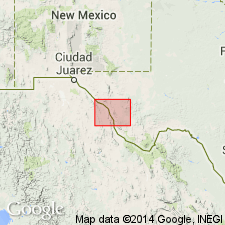
- Usage in publication:
-
- Adobe Canyon Formation
- Modifications:
-
- Mapped
- Geochronologic dating
- Dominant lithology:
-
- Rhyolite
- Trachyte
- AAPG geologic province:
-
- Permian basin
Summary:
Adobe Canyon Formation. Mapped in the Davis Mountains area, Jeff Davis County, West Texas. Consists of rhyolite and trachyte flows. A trachyte porphyry ("Big Brown Porphyry" Member) as much as 425 feet thick occurs at base; includes anorthoclase phenocrysts up to 8 mm in diameter and clinopyroxene microphenocrysts. Rest of formation consists of multiple flow units, massive at base, vesiculated near top; is gray, brownish-gray, or bluish-gray, weathers light-brown. Total thickness as much as 1,000 feet. Occurs above Gomez Tuff and below Frazier Canyon Formation (first used). [Author states that correlation of volcanic rocks from area to area on Marfa sheet is uncertain; little attempt is made to correlate between areas. The rocks are described by area.] Age is Oligocene; K-Ar age of 37.1 +/-0.4 Ma. obtained from 2 samples.
Source: Modified from GNU records (USGS DDS-6; Denver GNULEX).

- Usage in publication:
-
- Adobe Canyon Formation
- Modifications:
-
- Geochronologic dating
- AAPG geologic province:
-
- Permian basin
Summary:
Pg. 12. Adobe Canyon Formation. Rhyolite samples from Little Aguja Mountain and Robbers Roost Canyon quadrangles, Jeff Davis County, southwestern Texas, yielded K-Ar ages of 38.2 +/-0.8 Ma and 37.7 +/-0.8 Ma (alkali feldspar), respectively. Data from D.F. Parker and F.W. McDowell, 1979 (GSA Bull., v. 90, p. 1100-1110); ages recalculated using decay constants of Steiger and Jager, 1977 (Earth Planet. Sci. Letters, v. 36, p. 359-362). [Age considered Eocene. Eocene-Oligocene boundary 36.6 (38-34) Ma (from Geologic Names Committee, USGS, 1983 ed. geol. time scale, with additions from N.J. Snelling, 1985, The Geol. Soc. Mem., no. 10).]
Source: Publication.
For more information, please contact Nancy Stamm, Geologic Names Committee Secretary.
Asterisk (*) indicates published by U.S. Geological Survey authors.
"No current usage" (†) implies that a name has been abandoned or has fallen into disuse. Former usage and, if known, replacement name given in parentheses ( ).
Slash (/) indicates name conflicts with nomenclatural guidelines (CSN, 1933; ACSN, 1961, 1970; NACSN, 1983, 2005, 2021). May be explained within brackets ([ ]).

